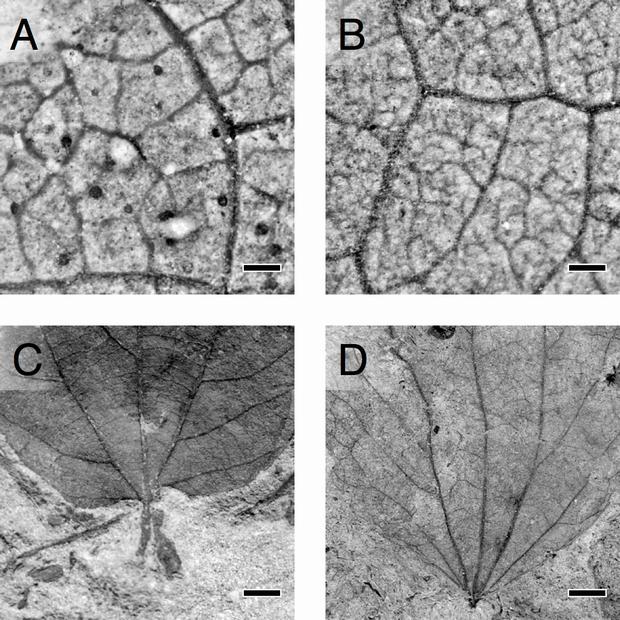66 million years ago, a 10 km diameter meteorite hit the Yucatan peninsula with the force of 100 teratons of TNT. It left a crater more than 150 km across and the resulting mega tsunami, wildfires, global earthquakes and volcanism are believed to have wiped out the dinosaurs and made way for the rise of the mammals.
It is still evident in the Chicxulub crater, named after the nearby village. It's also evident in the rise of plant life, according to a study which finds that the meteorite impact that spelled doom for dinosaurs also decimated evergreen flowering plants - and that allowed deciduous forests to grow. They hypothesize that the properties of deciduous plants made them better able to respond rapidly to chaotically varying post-apocalyptic climate conditions.
Applying biomechanical formulae to a treasure trove of thousands of fossilized leaves of angiosperms — flowering plants excluding conifers — the team was able to reconstruct the ecology of a diverse plant community thriving during a 2.2 million-year period spanning the cataclysmic impact event, believed to have wiped out more than half of plant species living at the time. The fossilized leaf samples span the last 1,400,000 years of the Cretaceous and the first 800,000 of the Paleogene.

Visual representations of trait changes across the KPB. Top row, increase in VD as seen in (A), “Dryophyllum” subfalcatum, −30.7 m stratigraphic depth, VD = 2.5 mm−1 and (B) unknown nonmonocot (morphospecies FU87), 1.275 m depth, VD = 5.3 mm−1. Bottom row, decreases in LMA as seen through decreasing PW for similar LA in (C) “Ficus” planicostata, −3.6 m depth, LMA = 136 g m−2 and (D) “Populus” nebrascensis, 7.2 m depth, LMA = 48 g m−2. Scale bar, (A and B) 500 µm and (C and D), 5 mm. Credit:
doi:10.1371/journal.pbio.1001949
The researchers found evidence that after the impact, fast-growing, deciduous angiosperms had replaced their slow-growing, evergreen peers to a large extent. Living examples of evergreen angiosperms, such as holly and ivy, tend to prefer shade, don't grow very fast and sport dark-colored leaves.
"When you look at forests around the world today, you don't see many forests dominated by evergreen flowering plants," said the study's lead author, Benjamin Blonder. "Instead, they are dominated by deciduous species, plants that lose their leaves at some point during the year."
Blonder and his colleagues studied a total of about 1,000 fossilized plant leaves collected from a location in southern North Dakota, embedded in rock layers known as the Hell Creek Formation, which at the end of the Cretaceous was a lowland floodplain crisscrossed by river channels. The collection consists of more than 10,000 identified plant fossils and is housed primarily at the Denver Museum of Nature and Science. "When you hold one of those leaves that is so exquisitely preserved in your hand knowing it's 66 million years old, it's a humbling feeling," said Blonder.
"If you think about a mass extinction caused by catastrophic event such as a meteorite impacting Earth, you might imagine all species are equally likely to die," Blonder said. "Survival of the fittest doesn't apply — the impact is like a reset button. The alternative hypothesis, however, is that some species had properties that enabled them to survive.
"Our study provides evidence of a dramatic shift from slow-growing plants to fast-growing species," he said. "This tells us that the extinction was not random, and the way in which a plant acquires resources predicts how it can respond to a major disturbance. And potentially this also tells us why we find that modern forests are generally deciduous and not evergreen."
Previously, other scientists found evidence of a dramatic drop in temperature caused by dust from the impact. "The hypothesis is that the impact winter introduced a very variable climate," Blonder said. "That would have favored plants that grew quickly and could take advantage of changing conditions, such as deciduous plants."
"We measured the mass of a given leaf in relation to its area, which tells us whether the leaf was a chunky, expensive one to make for the plant, or whether it was a more flimsy, cheap one," Blonder explained. "In other words, how much carbon the plant had invested in the leaf." In addition the researchers measured the density of the leaves' vein networks, a measure of the amount of water a plant can transpire and the rate at which it can acquire carbon.
"There is a spectrum between fast- and slow-growing species," said Blonder. "There is the 'live fast, die young' strategy and there is the 'slow but steady' strategy. You could compare it to financial strategies investing in stocks versus bonds." The analyses revealed that while slow-growing evergreens dominated the plant assemblages before the extinction event, fast-growing flowering species had taken their places afterward.






Comments